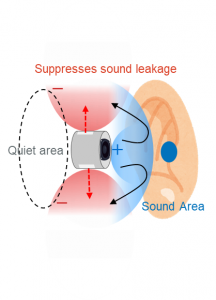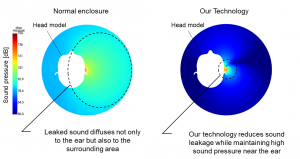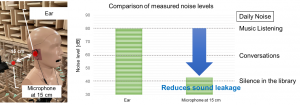NTT develops speaker enclosure design technology that holds sound in very small space

Tokyo. 9 November 2022 – NTT Corporation has announced that its Computer & Data Science Laboratories has developed a new speaker enclosure design technology that holds sound in a very small space. Our technology enables the development of open-ear earphones that do not leak sound. With these earphones, you will be able to communicate with people around you without worrying about sound leakage to the surroundings. Open-ear earphones using our technology will be exhibited at NTT R&D Forum Road to IOWN 2022.
With the increase in remote work and online education, earphones are becoming more and more necessary in our daily lives. However, wearing earphones for long periods of time places a heavy burden on the ears, and there are concerns about health risks. Canal-type earphones and headphones block out external sound, making it difficult to hear sounds around us or notice telephone calls or approaching vehicles. Open-ear earphones, such as neck speakers and bone-conduction earphones, have the disadvantage of leaking sound into the surroundings. Therefore, we have developed a speaker enclosure design technology that can realise open-ear earphones with minimal sound leakage.
The sound emitted by a typical speaker spreads in all directions. NTT has developed a new speaker enclosure design technique that uses only a single speaker to keep the sound in a localised space near the ear by drilling multiple holes at appropriate locations on the sides of the speaker enclosure. When positive-phase sound waves radiated from the front of the speaker reach the ear, they are reflected by the ear, generating sound waves that lead to sound leakage. Our technology suppresses these sound waves of sound leakage with sound waves in the opposite phase emitted from the holes in the sides of the speaker enclosure.
This enables the sound leakage to become very small as sound moves away from the ear. (Figure 1)

We have simulated sound leakage when an enclosure using our technology and a normal enclosure are worn on the ear. With the normal enclosure, high sound pressure can be observed not only at the ear but also over a wide area. On the other hand, with our technology, high sound pressure can be observed at the ear, while sound pressure around the head is low and sound leakage is reduced (see Figure 2).

We compare the noise level at the ear of an open-ear earphone using our technology with the noise level recorded by a microphone at a distance of 15 cm. We observe 80 dB at the ear but 43 dB at the microphone 15 cm away, which reduces sound leakage. The noise level at the ear is about as loud as listening to music, but at a distance of 15 cm, the noise level is equivalent to the quietness of a library (see Figure 3).

Our technology was developed with the aim of preventing sounds that we do not want to be heard from leaking into the surrounding environment without compromising comfort. We will continue to conduct research and development to realise the ultimate personal acoustic space and consider applications in various places such as airplanes, automobile seats, and offices.
Comment on this article below or via Twitter @IoTGN
